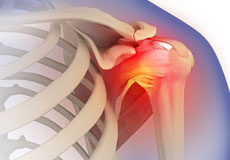What is Frozen Shoulder?

Frozen shoulder, also known as adhesive capsulitis, is a condition causing gradual pain and stiffness to the shoulder. Symptoms appear slowly and require a prolonged period of time to resolve.
Causes
The shoulder joint is comprised of bones, tendons, and ligaments that are encased in a capsule of connective tissue. Gradual thickening and tightening of this capsule surrounding the shoulder joint restrict shoulder movement causing a frozen shoulder. It is unclear why this happens, but it is sometimes associated with female sex, diabetes, hypothyroidism or a long period of immobilization followingg surgery.
Diagnosis
Frozen shoulder is diagnosed with a physical exam during which Dr. Stenson will evaluate your shoulder movements and assess for pain. You will be asked to perform certain arm movements to check the active range of motion and Dr. Stenson will maneuver your arm in different directions to check the passive range of motion.
Signs and Symptoms
The signs and symptoms of frozen shoulder develop gradually in three stages with each stage lasting for several months.
- The first stage is the freezing stage during which pain occurs with any shoulder movement and the range of motion of the shoulder gradually becomes limited. Pain may worsen at night disrupting sleep.
- Next is the frozen stage where the pain subsides but your shoulder stiffens up and cannot function properly.
- The final stage is the thawing stage during which shoulder movement begins to gradually improve.
Imaging studies such as an X-ray or MRI may be ordered to view the shoulder joint and rule out other problems.
Treatment
The various treatments used for frozen shoulder include:
- Pain-relieving medications
- Ice packs or heat application
- Physical therapy exercises
- Manipulation of the shoulder after administering anesthesia
If you do not get relief from the above methods, Dr. Stenson may recommend a minimally invasive surgery to remove scar tissue and adhesions within the shoulder.




